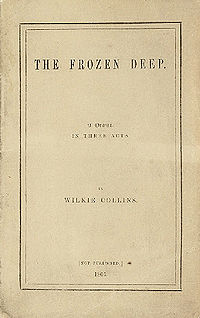The Frozen Deep

Cover of private printed first edition, 1866
|
|
| Author |
Wilkie Collins & Charles Dickens |
|---|---|
| Original title | The Frozen Deep. A Drama in Three Acts |
| Country | England |
| Language | English |
| Genre | Play |
| Publisher | Not Published |
|
Publication date
|
1866 |
| Media type | Print Paperback |
| Preceded by | The Village Coquettes |
| Followed by | No Thoroughfare |
The Frozen Deep is an 1856 play, originally staged as an amateur theatrical, written by Wilkie Collins under the substantial guidance of Charles Dickens. Dickens's hand was so prominent – beside acting in the play for several performances, he added a preface, altered lines, and attended to most of the props and sets – that the principal edition of the play is entitled "Under the Management of Charles Dickens". John C. Eckel wrote: "As usual with a play which passed into rehearsal under Dickens' auspices it came out improved. This was the case with The Frozen Deep. The changes were so numerous that the drama almost may be ascribed to Dickens". Dickens himself took the part of Richard Wardour and was stage-manager during its modest original staging in Dickens's home . The play, however, grew in influence through a series of outside performances, including one before Queen Victoria at the Royal Gallery of Illustration, and a three-performance run at the Manchester Free Trade Hall for the benefit of the Douglas Jerrold Fund to benefit the widow of Dickens's old friend, Douglas Jerrold. There, night after night, everyone – including, by some accounts, the carpenters and the stage-hands – was moved to tears by the play. It also brought Dickens together with Ellen Ternan, an actress he hired to play one of the parts, and for whom he would later leave his wife Catherine. The play remained unpublished until a private printing appeared sometime in 1866.
The play's genesis lay in the conflict between Dickens and John Rae's report on the fate of the Franklin expedition. In May 1845, the Franklin expedition left England in search of the Northwest Passage. It was last seen in July 1845, after which the members of the expedition were lost without trace. In October 1854, John Rae (using reports from "Eskimo" (Inuit) eyewitnesses, who informed that they had seen 40 "white men" and later 35 corpses) described the fate of the Franklin expedition a confidential report to the Admiralty: "From the mutilated state of many of the corpses and the contents of the kettles it is evident that our wretched countrymen had been driven to the last resource—cannibalism—as a means of prolonging survival."
...
Wikipedia
